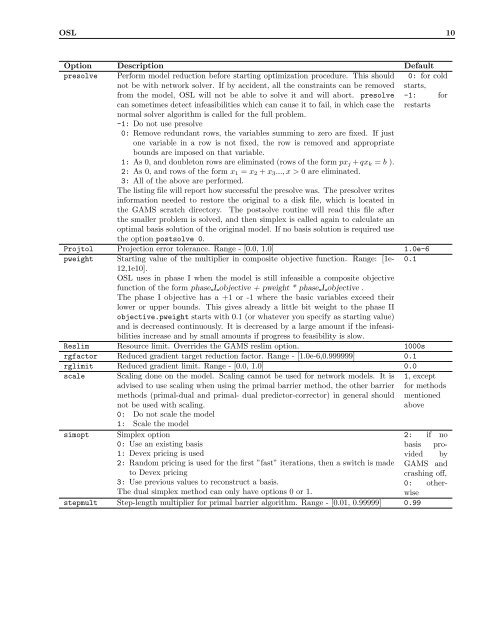<strong>OSL</strong> 10Option Description Defaultpresolve Perform model reduction before starting optimization procedure. This shouldnot be <strong>with</strong> network solver. If by accident, all the constraints can be removed0: for coldstarts,from the model, <strong>OSL</strong> will not be able <strong>to</strong> solve it and will abort. presolve -1: forcan sometimes detect infeasibilities which can cause it <strong>to</strong> fail, in which case the restartsnormal solver algorithm is called for the full problem.-1: Do not use presolve0: Remove redundant rows, the variables summing <strong>to</strong> zero are fixed. If jus<strong>to</strong>ne variable in a row is not fixed, the row is removed and appropriatebounds are imposed on that variable.1: As 0, and double<strong>to</strong>n rows are eliminated (rows of the form px j + qx k = b ).2: As 0, and rows of the form x 1 = x 2 + x 3 ..., x > 0 are eliminated.3: All of the above are performed.The listing file will report how successful the presolve was. The presolver writesinformation needed <strong>to</strong> res<strong>to</strong>re the original <strong>to</strong> a disk file, which is located inthe GAMS scratch direc<strong>to</strong>ry. The postsolve routine will read this file afterthe smaller problem is solved, and then simplex is called again <strong>to</strong> calculate anoptimal basis solution of the original model. If no basis solution is required usethe option postsolve 0.Proj<strong>to</strong>l Projection error <strong>to</strong>lerance. Range - [0.0, 1.0] 1.0e-6pweight Starting value of the multiplier in composite objective function. Range: [1e- 0.112,1e10].<strong>OSL</strong> uses in phase I when the model is still infeasible a composite objectivefunction of the form phase I objective + pweight * phase I objective .The phase I objective has a +1 or -1 where the basic variables exceed theirlower or upper bounds. This gives already a little bit weight <strong>to</strong> the phase IIobjective.pweight starts <strong>with</strong> 0.1 (or whatever you specify as starting value)and is decreased continuously. It is decreased by a large amount if the infeasibilitiesincrease and by small amounts if progress <strong>to</strong> feasibility is slow.Reslim Resource limit. Overrides the GAMS reslim option. 1000srgfac<strong>to</strong>r Reduced gradient target reduction fac<strong>to</strong>r. Range - [1.0e-6,0.999999] 0.1rglimit Reduced gradient limit. Range - [0.0, 1.0] 0.0scale Scaling done on the model. Scaling cannot be used for network models. It isadvised <strong>to</strong> use scaling when using the primal barrier method, the other barriermethods (primal-dual and primal- dual predic<strong>to</strong>r-correc<strong>to</strong>r) in general shouldnot be used <strong>with</strong> scaling.0: Do not scale the model1: Scale the model1, exceptfor methodsmentionedabovesimopt Simplex option2: if no0: Use an existing basisbasis provided1: Devex pricing is usedby2: Random pricing is used for the first ”fast” iterations, then a switch is made GAMS and<strong>to</strong> Devex pricingcrashing off,3: Use previous values <strong>to</strong> reconstruct a basis.0: otherwiseThe dual simplex method can only have options 0 or 1.stepmult Step-length multiplier for primal barrier algorithm. Range - [0.01, 0.99999] 0.99
<strong>OSL</strong> 11Option Description Defaultstrategy MIP strategy for deciding branching.None1: Perform probing only on satisfied 0-1 variables. This is the default settingin <strong>OSL</strong>. When a 0-1 variable is satisfied, <strong>OSL</strong> will do probing <strong>to</strong> determinewhat other variables can be fixed as a result. If this bit is not set, <strong>OSL</strong> willperform probing on all 0-1 variables. If they are still fractional, <strong>OSL</strong> willtry setting them both ways and use probing <strong>to</strong> build an implication list foreach direction.2: Use solution strategies that assume a valid integer solution has been found.<strong>OSL</strong> uses different strategies when looking for the first integer solution thanwhen looking for a better one. If you already have a solution from a previousrun and have set a cu<strong>to</strong>ff value, this option will cause <strong>OSL</strong> <strong>to</strong> operate asthough it already has an integer solution. This is beneficial for restartingand should reduce the time necessary <strong>to</strong> reach the optimal integer solution.4: Take the branch opposite the maximum pseudo-cost. Normally <strong>OSL</strong> willbranch on the node whose smaller pseudo-cost is highest. This has theeffect of choosing a node where both branches cause significant degradationin the objective function, probably allowing the tree <strong>to</strong> be pruned earlier.With this option, <strong>OSL</strong> will branch on the node whose larger pseudo-cost ishighest. The branch taken will be in the opposite direction of this cost. Thishas the effect of forcing the most nearly integer values <strong>to</strong> integers earlier andmay be useful when any integer solution is desired, even if not optimal. Herethe tree could potentially grow much larger, but if the search is successfuland any integer solution is adequate, then most of it will never have <strong>to</strong> beexplored.8: Compute new pseudo-costs as variables are branched on. Pseudo-costs arenormally left as is during the solution process. Setting this option will cause<strong>OSL</strong> <strong>to</strong> make new estimates, using heuristics, as each branch is selected.16:Compute new pseudo-costs for unsatisfied variables. Pseudo-costs are normallyleft as is during the solution process. Setting this option will cause<strong>OSL</strong> <strong>to</strong> make new estimates, using heuristics, for any unsatisfied variables’pseudo-costs in both directions. This is done only the first time the variableis found <strong>to</strong> be unsatisfied. In some cases, variables will be fixed <strong>to</strong> a boundby this process, leading <strong>to</strong> better performance in the branch and boundroutine. This work is equivalent <strong>to</strong> making two branches for every variableinvestigated.32:Compute pseudo-costs for satisfied variables as well as unsatisfied variables.Here, if 16 is also on, <strong>OSL</strong> will compute new estimated pseudo-costs for theunsatisfied as well as the unsatisfied ones. Again, this is very expensive, butcan improve performance on some problems.strategy can be a combination of the above options by adding up the valuesfor the individual options. 48 for instance will select 16 and 32.Target Target value for the objective. 5% worsethan therelaxedsolutionthreshold Supernode processing threshold. Range [0.0, maxreal] 0<strong>to</strong>lpinf Primal infeasibility <strong>to</strong>lerance. Row and column levels less than this values 1e-8outside their bounds are still considered feasible. Range: [1e-12,1e-1].<strong>to</strong>ldinf Dual infeasibility <strong>to</strong>lerance. Functions as optimality <strong>to</strong>lerance for primal simplex.1e-7Range: [1e-12,1e-1].<strong>to</strong>lint Integer <strong>to</strong>lerance Range - [1.0e-12, 1.0e-1] 1.0e-6workspace Memory allocation. Overrides the memory estimation and the workspace modelsuffix. Workspace is defined in Megabytes.None
















